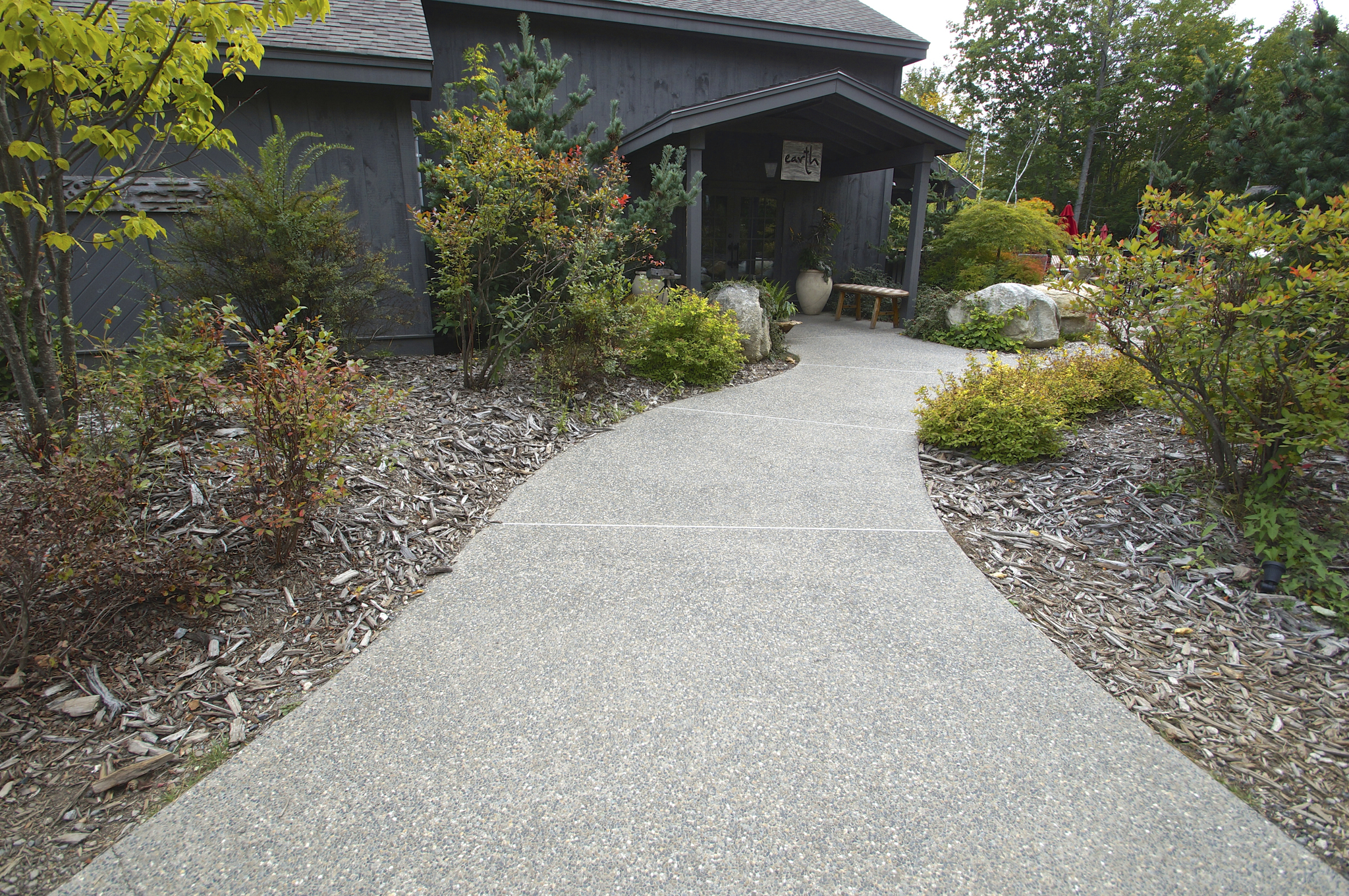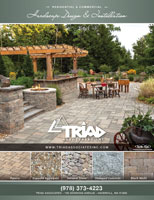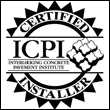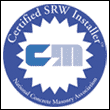Concrete is a versatile and affordable hardscaping material, making it a popular choice for many homeowners. However, not everyone likes the plain, gray surface that most concrete slabs have. Therefore, they opt for variations in the type of concrete or the treatment of the concrete to give them a different look. Exposed aggregate vs. stamped concrete are two popular options that Triad Associates regularly installs. Here’s a complete guide to tell you everything you need to know about exposed aggregate vs. stamped concrete.
What is Exposed Aggregate?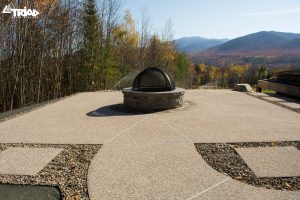
Concrete is composed of a mix of cement and aggregate. After it is poured, the surface is usually smoothed over, and what you see is a thin layer of cement. If you want a more decorative look, the surface can continue to be worked so that the aggregate below is exposed. Alternatively, aggregate can be added to the surface and worked in. Both methods result in a textured surface that can have different colors and designs. The concrete looks more visually appealing, and the textured surface helps to reduce slips and falls. When comparing exposed aggregate vs. stamped concrete, it’s important to consider the safety aspect that exposed aggregate can offer.
What is Stamped Concrete?
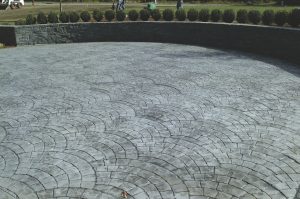 While concrete is drying, it can be imprinted with something to give it an interesting look. Most basic concrete projects have a broom finish, which means that a broom was run across the wet concrete to give it a slight pattern and texture. However, if you want more interesting or sophisticated design options, you can get stamped concrete. Different stamps can be used on the wet concrete to make it take on all types of looks, imitating pavers, natural stone, and more. In the debate between exposed aggregate vs. stamped concrete, stamped concrete stands out for its versatility in design.
While concrete is drying, it can be imprinted with something to give it an interesting look. Most basic concrete projects have a broom finish, which means that a broom was run across the wet concrete to give it a slight pattern and texture. However, if you want more interesting or sophisticated design options, you can get stamped concrete. Different stamps can be used on the wet concrete to make it take on all types of looks, imitating pavers, natural stone, and more. In the debate between exposed aggregate vs. stamped concrete, stamped concrete stands out for its versatility in design.
Aesthetic Appeal: Exposed Aggregate vs. Stamped Concrete
Exposed aggregate and stamped concrete offer great design options, but their aesthetic appeals to different sensibilities.
Exposed aggregate has a more rustic or natural look. It can also read as more utilitarian since it is often used in commercial concrete projects, particularly around pools. But you can experiment with different types of aggregate to achieve different looks with various colors, shapes, and sizes of glass, pebble, and more.
Stamped concrete has a much wider variety in the types of designs it can create. You can imitate just about any type of paver or stone with stamping, as well as different types of texture. Combine the stamping with staining and you open up a world of design possibilities. You can create any type of look you’d like. This is one of the key differences when considering exposed aggregate vs. stamped concrete.
Installation Process
The installation process for both exposed aggregate concrete and stamped concrete are very similar. The differences emerge in the finishing process.
Exposed Aggregate Installation
The first step to installing concrete is preparing the area. The ground may need to be dug out slightly, and it will need to be leveled. Depending on what kind of project you are installing and the needs of the surrounding landscape, a layer of gravel and sand may need to be laid. This will be leveled and tamped, in preparation for pouring the concrete on top of it. Forms are put in place in which to pour the concrete. The concrete is poured within the form, and it is worked to fill up the entire space, with no air pockets. It is then leveled with a screed.
To expose the aggregate, the surface is wet and worked over with a trowel. In other cases, the aggregate can be added to the surface after it has already been worked. The choice will depend on what type of aggregate you select. Comparing exposed aggregate vs. stamped concrete, this finishing step is unique to exposed aggregate.
Stamped Concrete Installation
The installation process for stamped concrete is the same as exposed aggregate up until the finishing process. Instead of working the surface to expose the aggregate, the surface is worked to be smooth and a stamp is applied. The stamp is moved from place to place until the pattern is completed across the entire surface. This key difference in the finishing process is often a deciding factor when choosing between exposed aggregate vs. stamped concrete.
Pros and Cons of Exposed Aggregate
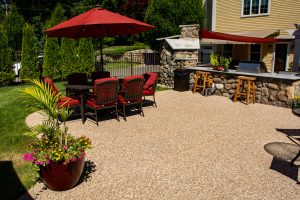 There are pros and cons of exposed aggregate to consider if you are planning a hardscape design and trying to decide on the best material. A few of these include:
There are pros and cons of exposed aggregate to consider if you are planning a hardscape design and trying to decide on the best material. A few of these include:
Pros
- Durable and long-lasting. It won’t easily be damaged, and it can last decades.
- Affordable cost. When compared to other decorative concrete options, it is on the more affordable side.
- Good traction. The textured surface makes exposed aggregate concrete a safer option around areas that get a lot of water.
- Low maintenance. You just need to brush the surface and keep it sealed.
Cons
- More expensive than standard concrete.
- More difficult to repair than standard concrete. You’ll have to get the same mix with the same aggregate, and even then, it can be difficult to match.
Pros and Cons of Stamped Concrete
Likewise, there are pros and cons of using stamped concrete that you’ll need to consider when planning your project. Here are some things to consider:
Pros
 Gorgeous design. Stamped concrete can be personalized to your style, and it will elevate any space.
Gorgeous design. Stamped concrete can be personalized to your style, and it will elevate any space.- More affordable than stone or pavers. Yet it can be stamped to look like either.
- Low maintenance. Just keep the concrete sealed, and it will keep looking great.
Cons
- More expensive than standard concrete.
- More difficult to repair. You can easily patch cracks and other damage, but matching the precise pattern or color may prove difficult, depending on the design.
When to Use Exposed Aggregate vs. Stamped Concrete
There is no right or wrong time to use exposed aggregate or stamped concrete. Often, the choice comes down to a design preference. However, exposed aggregate does have an edge for utilitarian spaces where there is a lot of foot traffic or may be a lot of exposure to water, such as pool decks or walkways. Stamped concrete is favored for patios and entry ways, where aesthetics play a bigger role.
Work with Triad Associates’ Concrete Experts
Call the concrete experts at Triad Associates today to explore your options for designing a gorgeous new hardscape! Whether you would like exposed aggregate or stamped concrete, we will design something beautiful for your space and install it expertly for long-lasting results. Contact us today to begin working with an experienced designer to transform your property.
